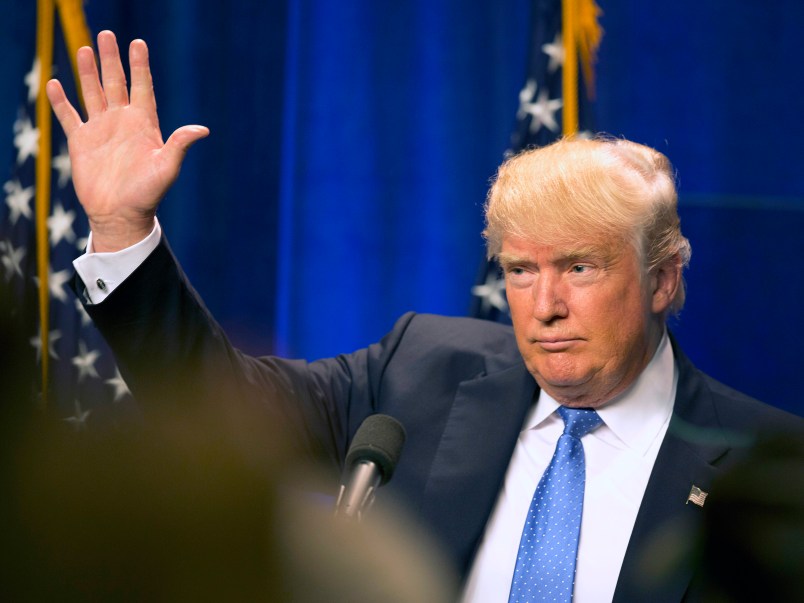With President Trump lying about widespread vote fraud in the 2016 election (which he won!), I thought it was time for a refresher and primer on the entire issue of voter fraud.
TPM has been reporting on this story as one of the central points of our editorial focus for more than fifteen years. I’m proud to say there is probably no issue about which we have more institutional knowledge and few publications that have more institutional knowledge of or experience reporting on this issue.
Voter fraud is extremely rare in the United States. Organized voter fraud (which is basically required to commit fraud at scale) is close to non-existent. And voter impersonation fraud – voting in the name of another person – all but never happens.
1. Let’s review some details. A 2014 study found 31 cases of ballot fraud out of a billion votes cast. Back in December, the Post’s Philip Bump found four documented cases of voter fraud in the entire 2016 election. These are but a couple examples, endlessly documented by TPM and other publications over the last decade and a half, documenting this point. There are dozens more studies of various scales, in various parts of the country and using different forms of evidence. They all arrive at the same conclusion. Indeed, if you remember, the 2006-07 US Attorney Firing scandal grew out of White House attempts to pressure US Attorneys to find and prosecute phantom cases of voter fraud. The US Attorneys in question were unable to find and then unwilling to manufacture it. That triggered efforts, beginning and in the White House and carried out in the Justice Department, to replace them with new US Attorneys who would ‘try harder’.
As we’ve also discussed at length, this entire obsession is rooted in the desire to make voting harder and suppress the vote of Democrats, minorities and the poor. But for the moment, I want to keep to the specifics about the claims themselves. Even to say ‘there’s no evidence’ for Trump’s claims is a cop-out. There’s also no evidence that Godzilla or King Kong exists. But we’re less tentative about saying someone’s either crazy or a liar if they say otherwise.
2. Most of the obfuscation and bamboozling about ‘voter fraud’ is actually about voter registration fraud. Unlike voter fraud, voter registration fraud does happen. Not a lot. But it does happen. It is important to understand what voter registration fraud is. It is almost entirely rooted to the fact that voter registration drives rely on paid workers. And they’re often paid by the signed up voter. This inevitably creates an incentive to submit bogus registrations. That’s how you get Mary Poppins and Mickey Mouse registered to vote. This is a serious crime which should be and is prosecuted. But here’s the catch. Mickey Mouse is not a real person. Neither is Mary Poppins. So the fact that their names might occasionally show up on voter rolls is an administrative nuisance, not a threat to the integrity of elections. (The real victim in almost every case of voter registration fraud is the organization who was paying to get real voters registered.) Of course, sometimes the fake registration is Joe Smith. In theory, someone could show up with a fake ID for Joe Smith and cast a fraudulent vote. In practice, there’s zero evidence this happens.
If you think about it, there’s a good reason why: it is a wildly inefficient way to shift elections or accomplish anything. To operate at scale, a substantial number of people have to commit serious felonies and thus risk serious jail time, coordinate fake identities, identify people who will actually cast the ballots, etc. Conspiracies at scale are hard to keep secret. It’s far more efficient just to find eligible voters to vote. It’s true that one person could fraudulently register under five different names for five different precincts and then vote in each on election day. But if you consider the incentives – major felonies and jail time risked for a totally inconsequential effect on an election – you can see why this simply doesn’t happen. Indeed, hypotheticals aren’t the point. The key is the evidence. It’s not just numerous studies demonstrating the virtual non-existence of voter impersonation fraud. We have numerous cases of elected officials launching probes trying to find evidence of voter fraud to further political agendas and finding nothing. The evidence tells the story: voter impersonation fraud is close to non-existent in contemporary America.
Impersonation voter fraud is not the only kind of voter fraud. In recent decades the real source of election fraud is tied to absentee ballots. Still very rare. But it does happen. The problem is that Voter ID laws are only relevant for voter impersonation fraud, which essentially doesn’t exist. But Voter ID laws help suppress voting. That’s why we have them. The reality is that to commit voter fraud at scale it basically has to be done by the people running the election, not the folks voting. And there are various reforms from the mid-20th century forward which make that very rare.
3: Are undocumented immigrants (“illegals”) voting? Forget about insane conspiracy theories about millions of ineligible voters voting, are small but significant numbers doing so? The evidence says no, the same scale of evidence noted above. Why? The most obvious answer is that undocumented immigrants tend to steer clear of interaction with the state whenever possible. After all, they’re subject to deportation! But again, there’s no evidence. And many, many interested parties have tried to find it.
4. Are there dead people on the voting rolls? Yes, there. Why? Here’s the thing: We all die! (I’m sorry.) The other thing is this: The United States has a highly localized, mainly-unintegrated and deeply underfunded voter system. When someone dies, there’s no immediate or efficient way names get taken off the rolls. Some jurisdictions review death certificates, some don’t. Of course, people don’t necessarily die where they were registered to vote. Their death certificates may not precisely match their name on the voting rolls. The addresses may not be the same.
Something comparable applies when you move. If you used to live in another state, did you notify the state you left that you were leaving and should no longer be registered to vote? Hint: don’t pretend you did. You didn’t. There are ways that registrars try to take account of who’s left the jurisdiction. But they tend to be haphazard and are very uneven across jurisdictions. The upshot is that with a mobile population and the continued existence of death, it is inevitable that voter rolls include lots of people who either no longer live in the jurisdiction or no longer live at all. The obvious answer is to purge the voting rolls of people who either haven’t voted in a long time or whose names show up on death certificates or who can be cross-referenced with other data. But these ‘purges’, because of the haphazard nature of the entire voting system, usually end up purging totally legitimate voters. Is Joe Jones who moved to Nebraska the same one who is registered in California? Indeed, this is a major reason why many purges take place – to knock people off the rolls for the purposes of voter suppression.
It would be possible to create a national voter registration system which integrated citizenship records, death records, records of movement and residency and kept the vote rolls clean and up to date. But it would cost a lot of money and run afoul of all sorts of federalism and (potentially) privacy concerns. It would also make it much, much easier to vote. And Republicans have been committed to preventing that for some time. Basically, as a country, we’ve made a choice to have a disorganized and underfunded voting system. That virtually guarantees out of date voter rolls. That’s not good. But there’s zero evidence those out of date rolls are used for fraud. So basically it’s not a problem, even though people exploit scary data (millions of dead people on the voting rolls!!!) for the purposes of making it hard for non-white people and poor people of all races to vote. Because people are basically terrible and have no shame.
That’s the story. Voter fraud is close to non-existent in the United States going back more than half a century. When it’s brought up, it is almost always to discredit fair elections or with the political agenda of making it hard to vote. The folks who push this are liars.








